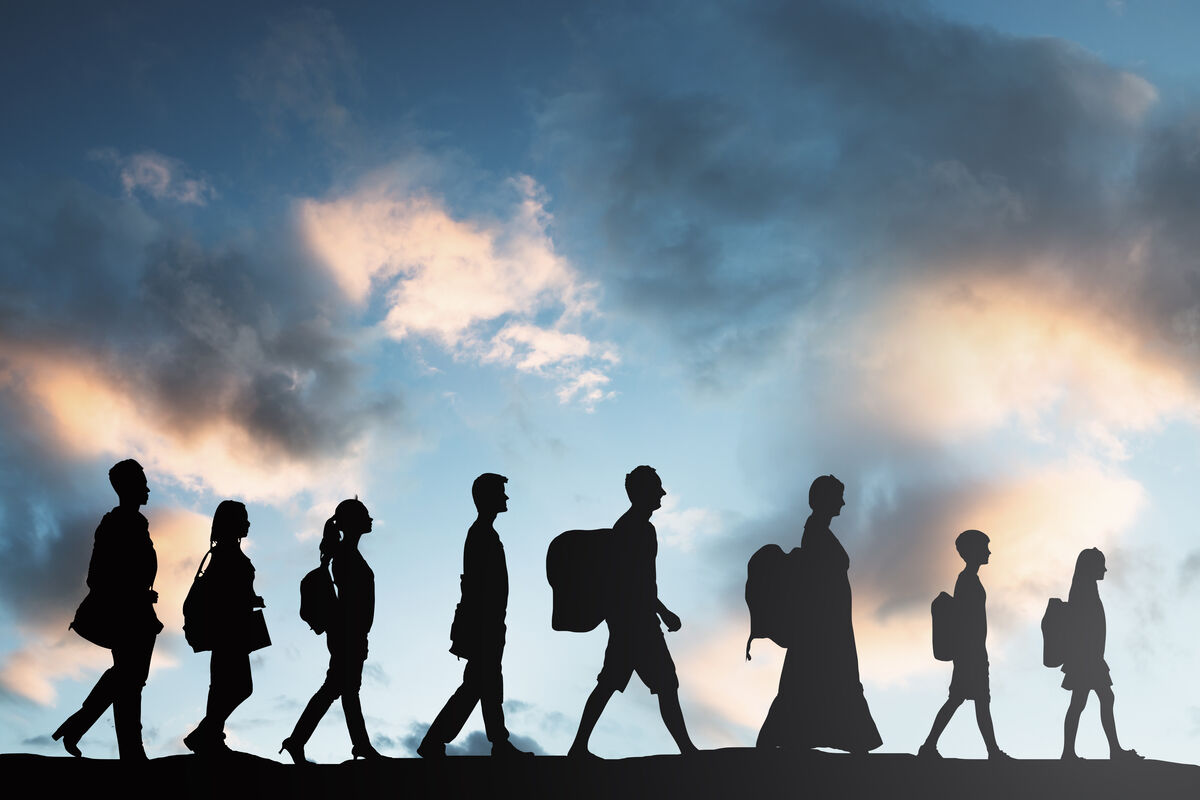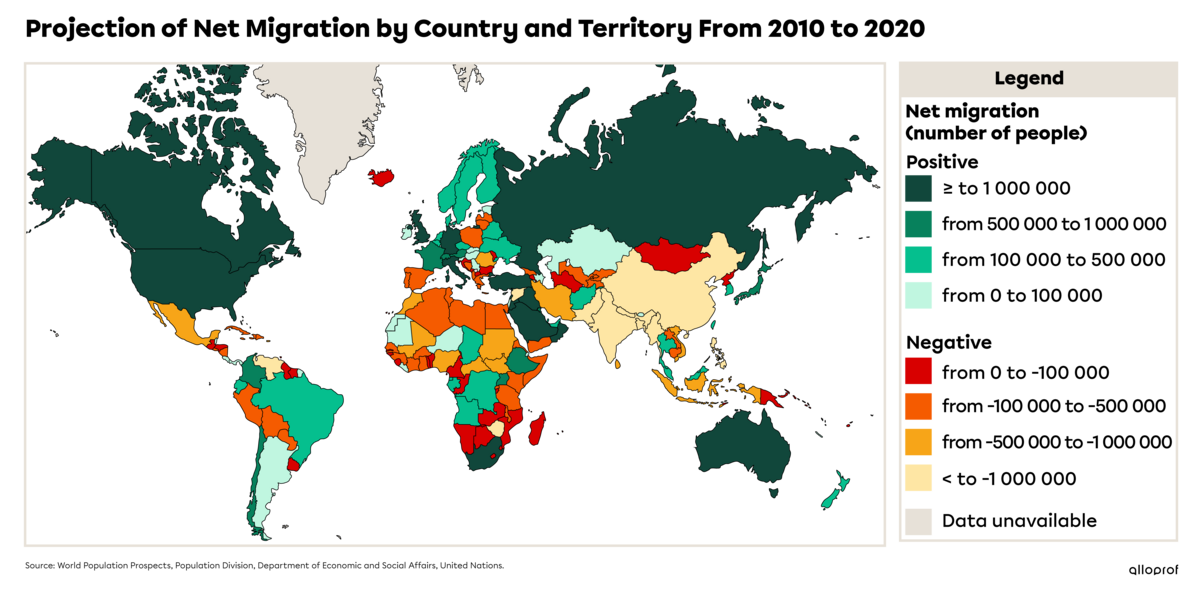
In 2015, 21.80% of the population in Canada–representing 7 835 502 people–was reportedly born outside the country. The following graphs show that migration to Canada has been increasing for many years.


But this is not unique to Canada. The entire world is in motion. In 2019, the United Nations (UN) estimated that the number of international migrants was 272 million. This refers to the number of people living in a country other than the one in which they were born. The following map shows net migration by country and territory:

When net migration is positive, it means that there are more immigrants than emigrants. When net migration is negative, it means that there are more emigrants than immigrants.
-
Net migration is the difference between the number of immigrants and the number of emigrants within a country.
Immigrants - Emigrants = Net migration -
An immigrant is a person who settles in a foreign country (host country), temporarily or permanently, after leaving their country of origin (home country).
-
An emigrant is a person who leaves their country (country of departure) to settle in another country (host country).
Migration is the movement of people from their place of origin to another place for various reasons. These reasons may be personal, religious, cultural, political, ecological or economic. This physical movement can happen inside and outside of a country.
Ali is from Cameroon and hopes to find better living conditions in Canada, such as better health care, better employment, etc.
Max is an American who no longer wants to live in his home country after a new president was elected. He does not like the way the country is run now.
Samantha is from France, and she is moving to join her husband who has been working in Montreal for a year.
Antonio is Italian, and he decided to move to Montreal’s Little Italy where many Italians already live.
Jessica has dreamed of living in England since she was a little girl. This fall, she decided to move there after landing a job in London.
The different types of migration are categorized based on how long a migrant stays in the host country, the migrant’s place of departure and destination, the reasons for the migrant’s departure and the migrant’s status. The different migration categories are:
-
permanent or temporary
-
voluntary or forced
-
internal or external
-
legal or irregular (undocumented or clandestine)
Permanent Migration
When someone migrates permanently, their place of arrival becomes their new permanent home.
Antonin and his girlfriend Nadia have decided to leave France and move to Quebec for good. They bought a one-way ticket and have a work permit. They arrived six months ago and have started a new life. They showed up with their four suitcases and now live in a five-and-half-room furnished apartment in a quiet area of Quebec City. After a few months of searching, they both found jobs in their fields. They hope to become permanent residents and eventually, Canadian citizens.
Temporary Migration
When someone migrates temporarily, their place of arrival is not their new permanent home. They are moving for a short period of time. This can be for several reasons:
-
seasonal work
-
studying abroad
-
short-term work
Sometimes temporary migration becomes permanent.
Mamadou has been in Montreal for a year and a half. He left his native Mali to study engineering at a university in Quebec. Once he graduates, he intends to return to Mali to start working at his family’s company. He lives in university housing and has few possessions.
Voluntary Migration
Some people willingly decide to leave their home and move to another place.
Jacques is leaving Belgium because the company he works for offered him an exciting position in Sherbrooke for the next three years. He accepted the opportunity and is not sure whether he will stay in Canada permanently. He is waiting to see how the job goes, and if he likes the new area.
Forced Migration
Some people are forced to leave their homes. These people do not want to move, but are often forced to in order to survive. Causes of forced migration include war, dire economic situations, natural disasters, climate change or discrimination against a political opinion, ethnicity, religion or social reasons.
Ines, her husband and her children were forced to abruptly leave their home when their village in Syria was bombed. A few hours after the attack, they left their home on foot, each with a backpack full of essentials. They walked to a refugee camp in Turkey. Once there, they applied for refugee status under the Geneva Convention. They wanted to move to the United Kingdom.
Internal Migration
Internal migration is movement within a country. An internal migrant moves to another village, town, region or province, but not to another country.
Maella comes from a small village in Côte-Nord. She has finished high school and wants to learn a trade that is not taught in her region. She had to move to Trois-Rivières to study.
External Migration
External migration is movement outside of a country.
Brian moved from the United States to British Columbia, Canada.
Legal Migration
A legal migrant follows the host country’s immigration rules and laws.
Bénédicte came from France to work in Quebec after being recruited by a company. She had a work permit when she arrived. After her employment contract ended, she applied for and received permanent residence in Canada. She is now applying for Canadian citizenship.
Irregular Migration
An irregular immigrant does not follow the host country’s immigration rules and laws and lives in a country without official permission. These people are also referred to as undocumented immigrants.
Gildas is Congolese and decided to try his luck in Europe and move to England. He initially applied to the British government for immigration, but his application was rejected. He decided to immigrate anyway. He flew to England on a three-month tourist visa but ended up overstaying his visa. Since he had no legal status, he had to work illegally under very poor conditions.
Anyone can become a migrant. Most migrants are:
-
young people of working age
-
both men and women
-
primarily from developing countries
The main immigration regions (to which migrants move) are:
-
North America
-
Western Europe
-
The Persian Gulf States
-
Australia

Migration flows refer to the displacements of populations. These displacements can occur within the same country or from a country of departure to a host country.
These are main reasons for the significant increase in migration in recent decades:
-
Better transportation and communication methods
-
Wealth gaps between countries
-
Globalization
-
Corporate outsourcing
-
Political instability
-
Climate change
Changing trends explain why migration is increasing around the world. The estimated number of international migrants was 80 million in 1975 and 272 million in 2019, a 340% increase since 1975. This increase can also be explained by the rising world population.
Unlike the past few hundred years, humans now have access to transportation methods to travel long distances in a short amount of time, especially by plane. It only takes a few hours to travel from one continent to another.
When people living in developing countries are faced with dire economic situations, they consider migrating to a country with better economic opportunities to improve their lives.
Globalization is not just about increased trade in goods and services between countries, but also greater labour mobility. For example, a company that does business internationally may ask an employee to work in one of its offices abroad.
Globalization has led many companies to move their production sites to developing countries. This job creation explains why so many people move to find work in new regions of production.
Outsourcing refers to the relocation of part or all of a company’s activities to another country in order to reduce production costs. Relocation generally occurs from developed countries towards developing or emerging countries.
Many countries in Africa, Asia and the Middle East are experiencing difficult political situations that will lead to social tensions, conflicts and economic crises. Some people want better living conditions for themselves and their families, so they decide to try their luck in a more stable country. Some countries in Latin and Central America are experiencing this kind of situation, but on a smaller scale.
Climate change and natural disasters can also cause people to leave their homes. This happened in Haiti after the 2010 earthquake. Numerous Haitians left their home country after this terrible event, with many of them moving to Quebec.
The main factors considered when choosing a host country are:
-
Geographic proximity
-
Language
-
The presence of family or community members (diaspora)
-
Historical connection with the country
-
Job opportunities
-
When choosing a host country, migrants tend to move to areas close to their home country. Many people from North Africa have moved to Europe due to their proximity.
Another factor that comes into play is language. Logically, it is easier to fit into a country that speaks the same language.
Migrants may also consider the presence of family or community members when choosing a host country.
Many migrants choose to move to countries that have a historical connection to their home country. For example, several people from former French colonies in Africa have moved to France.
Finally, job opportunities are a major factor to consider when choosing a host country. It is better to live in a place where a good standard of living can be achieved.
In Quebec, most immigrants are young people of working age. 76% of immigrants are between 25 and 64 years old. Only 1.8% are aged 65 and over.
|
Distribution of Quebec immigrants by age group from 2008 to 2017 |
|
|
Age group |
% |
|
0-14 years |
22.1 |
|
15-24 years |
11.0 |
|
25-34 years |
37.1 |
|
35-44 years |
20.2 |
|
45-64 years |
7.7 |
|
65+ years |
1.8 |
The percentage of male and female immigrants is quite similar (51.5% women and 48.5% men). Below is an overview of different immigrant profiles:
-
61.4% immigrated due to economic reasons
-
24.3% immigrated to join family
-
12.6% are refugees or people in similar situations
More than 2/3 (64.7%) of these people knew French upon entry. Immigrants are usually highly educated. 29% have between 14 and 16 years of education and 29.9% have more than 17 years of education. Immigrants come from the following continents:

Immigrants to Quebec mainly come from Africa and Asia.
The top ten home countries of Quebec immigrants are:
-
France
-
Algeria
-
Haiti
-
Morocco
-
China
-
Colombia
-
Cameroon
-
Syria
-
The Philippines
-
Iran
The distribution of immigrants across the province of Quebec varies greatly with more than half (55.8%) moving to the Montreal area.
|
Distribution of Immigrants by Region of Residence From 2008 to 2017 |
||
|
Region |
Number of immigrants |
% |
|
Bas-Saint-Laurent |
859 |
0.2 |
|
Saguenay–Lac-Saint-Jean |
957 |
0.3 |
|
Capitale-Nationale |
21 042 |
5.6 |
|
Mauricie |
2 879 |
0.8 |
|
Estrie |
7 006 |
1.9 |
|
Montréal |
209 577 |
55.8 |
|
Outaouais |
12 858 |
3.4 |
|
Abitibi-Témiscamingue |
1 020 |
0.3 |
|
Côte-Nord |
438 |
0.1 |
|
Nord-du-Québec |
219 |
0.1 |
|
Gaspésie - Îles-de-la-Madeleine |
331 |
0.1 |
|
Chaudière-Appalaches |
3 075 |
0.8 |
|
Lanaudière |
8 635 |
2.3 |
|
Laurentides |
9 521 |
2.5 |
|
Longueuil |
29 491 |
7.9 |
|
CRÉ-Montérégie Est |
9 050 |
2.4 |
|
CRÉ-Vallée-du-Haut-Saint-Laurent |
13 145 |
3.5 |
|
Centre-du-Québec |
2 236 |
0.6 |
|
Total |
375 518 |
100 |